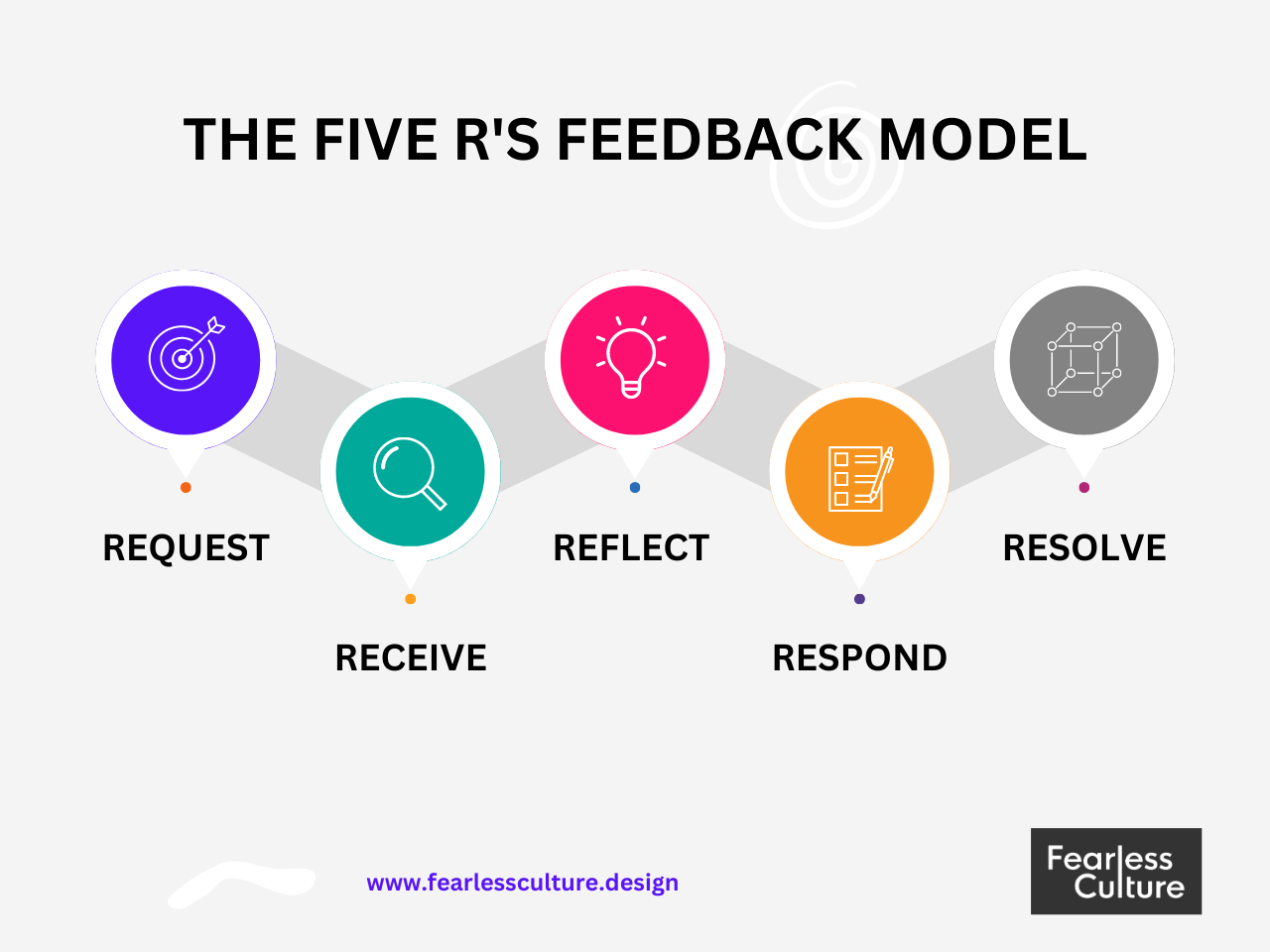The Five R's of Feedback: A Blueprint for Personal and Team Growth
A five-step approach to turn a thorny experience into blooming success

In today’s diverse workplace landscape, feedback is a vital element that helps teams grow. As the late CEO of Zappos, Tony Hsieh, once said, the role of a leader is to be the architect of the greenhouse. Leaders shouldn’t tell each plant how to grow but create an environment in which they can flourish on their own.
But here's the rub: Just as gardening requires knowledge and skill, so does giving and receiving feedback. It can be uncomfortable, sometimes contentious, and if not done right, it can do more harm than good — like overwatering a plant or exposing it to too much sunlight.
I’m thrilled to share the five-step feedback framework I use with my clients. It boosts team members' ability to give and receive feedback more effectively. Mastering each step is vital to nurture a culture of continuous learning.
The 5 R’s Feedback Model
The 5 R’s Feedback Model includes five steps: Request, Receive, Reflect, Respond, and Resolve. Let's review each step and learn how to use them, whether you're giving or receiving feedback.

1. Request: Taking the Initiative
Unsolicited feedback often backfires: It not only fails to benefit the recipient, but it also makes the giver feel powerful, according to research. This might be less surprising to women, who are more likely to receive unsolicited feedback.
That’s why taking the initiative is vital. In my experience working with teams, requesting feedback creates a sense of ownership, allowing people to feel in control – unlike formal feedback practices like performance reviews.
When you request feedback, you can also ask for the type of help you need on your own terms.
Leaders often think feedback is about telling people how to improve – prescribing a solution. However, feedback comes in many shapes and forms. For instance, you might need help reframing the problem, asking better questions, or brainstorming possible solutions.
Peer-to-peer feedback is often more effective because people feel less defensive talking to their colleagues than their manager. Most importantly, the people with whom you spend the most time – your team members – know you better.
Patagonia has created a culture of collective feedback by training managers to ask for feedback rather than provide it. By modeling being a good receiver, managers encourage others to ask for feedback, too.
The first step in the 5 R’s process is Request. Take the initiative to seek feedback, clearly defining what kind of help you need.
2. Receive: Active Listening
In the words of Ken Blanchard, "Feedback is the breakfast of champions." But let's be honest: it's not always easy to swallow.
Feedback can trigger multiple reactions based on our personal history, our relationship with the person giving the feedback, and, of course, the truth itself. It’s not pleasant to be reminded of our flaws or mistakes. Research shows that focusing on shortcomings doesn’t enable learning but impairs it.
In the book Nine Lies About Work, the authors challenge the conventional wisdom that “people need feedback.” Our contemporary over-enthusiasm for feedback is a reaction to the ‘absurd infrequency’ of annual appraisals. Feedback is a dish that should be served warm: the more frequent and real-time, the better.
Feedback is not the reality but rather an opinion. Effective feedback can help you turn your blind spots into bright spots. Conversely, biased feedback can trigger false alarms, like a park assist system that starts beeping even when the object is still far from the car.
Actively listen when receiving feedback. Hear what the other person has to say without interrupting. Let them do the talk.
At Airbnb, teams practice "Elephant, Dead Fish, Vomit" feedback sessions. Employees are encouraged to bring up any issues (the "elephants" in the room, "dead fish" from the past, or "vomit" that they just need to get out). Everyone is expected to listen actively and respectfully, without immediately jumping to solutions.
The second step is Receive. This involves actively listening to what the other person says without interrupting. It's about asking clarifying questions – if needed – and acknowledging the feedback with gratitude.
3. Reflect: Gaining Insights
Feedback is a dish that should be served warm but digested cold.
Take time to reflect before reacting to feedback. Consider its validity and relevance, and gain insights into your own performance or behavior. Reflection can help you understand what you can — or want to — change.
While reflecting can be done immediately, it's often helpful to take some time to let it simmer.
Review or reevaluate a situation, performance, or idea based on feedback. Taking a fresh look at the feedback and considering its implications will help you identify areas for growth or change.
Don’t immediately discard feedback if it feels completely off. Are you missing something? What is the feedback triggering? Why does it hurt?
Feedback is a gift. Welcoming it doesn’t mean that you will use it all the time.
Spotify runs "Health Checks" to uncover patterns between different teams. During these regular check-ins, Squads step back from their day-to-day activities and reflect on the health of the team, product, and tech. All results are aggregated in a multi-team-level visualization to reflect on patterns and trends.
The third step in the 5 R’s Feedback Process is Reflect. Take the time to consider and define what you will change.
4. Respond: Constructively Reply
Closing the loop helps demonstrate gratitude, but it also — and most importantly — that you are worth the effort. When you request feedback, you ask people to invest their time and energy.
Get back to the feedback giver. Depending on the situation's complexity, this can be right after you receive the feedback or after a few days of reflection.
"Respond" refers to providing a thoughtful and constructive reply or reaction to the feedback received. When someone receives feedback, it is vital to respond in a way that acknowledges and appreciates the feedback while also addressing any concerns or suggestions.
Salesforce uses a goal-setting process called "V2MOM" (Vision, Values, Methods, Obstacles, Measures). Employees are encouraged to respond constructively by updating their V2MOM to reflect any changes or improvements they need to make based on the feedback.
The fourth step is Respond. Get back to the feedback giver, and show them genuine respect by sharing how you intentionally reflected on their input.
5. Resolve: Commit to Grow
Feedback is a gift. Always be open and thankful, but it’s up to you to decide how and when to use it.
“Resolve” entails addressing or resolving the issues, concerns, or suggestions raised in the feedback. It involves actively resolving conflicts, addressing identified weaknesses, or implementing changes based on the feedback received.
Resolving feedback demonstrates a commitment to growth, improvement, and problem-solving within a team setting. Outline the steps you plan to take based on your reflection.
Pixar hosts "Braintrusts" in which filmmakers present their work to a peer group for critique. Teams can then decide whether or not to adopt the feedback received. However, they’re fully accountable if things go wrong because they dismissed the feedback.
The fifth and final step is Resolve: Address the feedback and make necessary changes. Demonstrate your commitment to growth and improvement by outlining the steps you plan to take.

Using the 5 R’s Feedback Model: Tips And Common Mistakes to Avoid
Let’s discuss practical tips for both givers and receivers, highlighting common pitfalls to avoid. Whether giving or receiving feedback, these insights will help you communicate effectively and foster growth. Let's dive in.
1. Request
Giver: Be open and approachable. Encourage others to request feedback from you. Establish clear rules of engagement and what the recipient needs.
Avoid saying “yes” if you’re not committed to practicing compassionate candor – or putting in the effort to provide meaningful feedback.
Recipient: Don't wait for feedback to come to you. Be proactive in asking for it and clearly define what kind of feedback you're looking for. Feedback can come in many shapes and forms, such as guidance, coaching, validation, peer review, positive reinforcement, constructive criticism, or advice.
What kind of help do you need? The more specific you are, the more valuable the feedback will be.
2. Receive
Giver: Deliver your feedback clearly and concisely. Be patient and give the receiver time to process the information.
Avoid prescribing your solution; help people find theirs. In Tony Hsieh's words: “Don’t be the plant that every other plant aspires to.” Instead, create the conditions for others to bloom.
Assess the behavior, not the person. Provide feedback through questions rather than mandating a solution. Change happens from within. Effective feedback keeps people thinking, not hurting.
Feedback is not the truth but rather your opinion. When expressing feedback, use phrases such as "I think..." to clarify that it’s your personal perspective.
Recipient: Listen attentively and resist the urge to interrupt or defend yourself. Show appreciation for the feedback received, even if it's tough to hear. Remember, your goal is to learn and grow.
Ask clarifying questions to make sure you understand the feedback. This can involve asking open questions or seeking further examples to ensure you clearly understood the input received.
Avoid becoming defensive or dismissive when receiving feedback. This can discourage others from giving you feedback in the future.
3. Reflect
Giver: Give the receiver time to reflect on the feedback. Understand that immediate change may not be possible and that reflection is crucial to the process.
Recipient: Avoid rushing the reflection process. Take the time you need to fully process and understand the feedback. Consider its relevance and validity. When receiving feedback, it’s important not to rush to make changes. Instead, intentionally choose which parts of the feedback to act upon.
4. Respond
Giver: Be open to dialogue. Once the receiver has had time to reflect, they may have questions or need further clarification. Be prepared to engage in this conversation and provide additional feedback, if necessary.
Recipient: After reflecting on the feedback, respond to the giver. This could be to seek further clarification, discuss your reflections, or share your action plan. This shows that you value their feedback and are taking steps to act on it. Avoid responding to feedback in the heat of the moment. Take the time to reflect and respond thoughtfully.
5. Resolve
Giver: Follow up on the feedback given. Check in with the receiver to see how they're progressing with their action plan. This shows your commitment to their growth and development.
Recipient: Create an action plan based on the feedback and your reflections. Share this plan with the person who gave you feedback. This demonstrates your commitment to growth and improvement.
Avoid ignoring feedback or failing to act on it. The goal of feedback is not just to hear about your areas of improvement, but to act on them.
Download your free copy of the Feedback Checklist guide – a set of questions to work on for each step.
Practice the Five R's of Feedback
The Five R’s of Feedback Model provides a structured approach to giving and receiving feedback, capturing the whole cycle. By embracing this approach, you can become better at giving feedback.
Feedback is a vital nutrient for teams to thrive. It’s the sunlight and water nurturing team and personal development. Get ready to cultivate a culture of continuous learning and improvement.
If you want to improve how your team gives and receives feedback, schedule a free consultation with me.




